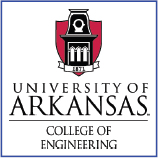Engineering Career Awareness Program
Lead Institution: University of Arkansas, Fayetteville, AR
Collaborating Institutions: Dual degree programs: Fort Valley State University (Fort Valley, GA), Philander Smith College (Little Rock, AR), University of Arkansas at Pine Bluff (Pine Bluff, AR), Pulaski Technical College (Little Rock, AR), Crowder College (Neosho, MO), and Northwest Arkansas Community College (Bentonville, AR). Other universities provide sites for REU experiences, and corporations provide support and internships.
Category: Extracurricular/Retention
Date Implemented: Fall 2007
Website: ecap.uark.edu


Program Description: The goal of the Engineering Career Awareness Program (ECAP) is to increase the number of underrepresented students, especially those who are capable but financially challenged, who obtain engineering degrees and enter engineering graduate studies or the engineering workforce. ECAP recruitment strategies include: informational outreach efforts with large populations of underrepresented students, making presentations, educating counselors and talking individually to students; involving current minority engineering students who can relate well to future ECAP students; disseminating scholarships and financial aid information to underrepresented students to assist them in navigating the complicated scholarship and financial aid system; and forming partnerships with HBCUs. ECAP includes six retention elements: a three-week summer in-residence engineering bridge program to allow students to engage in engineering/teambuilding activities, make friends, and transition to campus life; renewable scholarships, which supplement other scholarships and grants to make each student’s total award equal to the cost of attendance; yearly paid summer co-op/internship, research, or study abroad opportunities; mentoring by junior and senior ECAP students; a living-learning community; and a Freshman Engineering Program designed to increase retention of all freshman students through block scheduling and specialized services. The Biological, Chemical, Civil, Computer Science & Engineering, Electrical, Industrial, and Mechanical Engineering departments all support ECAP students financially through departmental scholarships and provide additional faculty mentoring, while the Freshman Engineering Program facilitates specialized tutoring and peer mentoring by other ECAP students. The Honors College provides competitive study abroad and undergraduate research grants as well as scholarships for high-achieving entering students. The Enrollment Management Office, which includes the Scholarship Office, assists in identifying potential ECAP students and awarding the Silas Hunt Scholarship. The Office of Diversity Affairs, which includes the Multicultural Center and Pre-College Programs, provides support for the ECAP Summer Bridge Program as well as additional mentoring support for ECAP students. University Housing, Development and the Career Development Center also play integral roles.
Anticipated and Actual Outcomes: Since ECAP’s implementation, the number of new freshmen ethnic minority students has increased 190% to 20% of the class in 2011. The University competitively awards a Silas Hunt Scholarship to underrepresented students, and ECAP has raised its acceptance rate from 60% to 79% and increased the number of engineering recipients. The retention and graduation rates of ECAP students are significantly higher than those of non-ECAP students. ECAP students completed internships with at least 24 companies and participated in REU programs at 8 other universities. Of the 2011 graduates, 27% pursued engineering graduate degrees and the rest obtained placement with corporations with an average starting salary of $62,000. In addition, ECAP students are highly sought after by numerous corporations looking for diverse engineering talent. Several companies have hired ECAP students for internships or full-time employment and have participated in the ECAP Executive Speaker Dinner Series.
Assessment Information: ECAP is part of a formal research program started in 2008 as part of work funded by NSF to determine quantitative and qualitative factors that impact and predict student success beyond grades, financial need, social integration, and student satisfaction. This longitudinal research study integrates demographic, academic, and financial data with data from an annual survey asking engineering students about their satisfaction with the college retention and degree programs, integration and comfort level with people from diverse populations and with majority populations, alcohol and substance use, physical and mental health, religion, sexual orientation, and other factors rarely assessed. In addition, the project hired an external evaluator to collect data from independent sources to determine whether stated quantitative benchmark objectives are met and to implement systematic qualitative evaluation techniques to support the quantitative information. The seven evaluated program elements are: 1) recruitment, 2) the Freshman Engineering Program, 3) peer mentoring, 4) co-ops, internships, or summer research experience, 5) summer bridge program, 6) scholarships, and 7) the living-learning community. This approach helped determine which program elements require incremental improvement, while still supporting the ongoing overall project assessment.
Funding/Sustainability: In Fall 2006, the College of Engineering committed $100,000 for the startup of ECAP, including a $51,000 marketing plan, $24,000 in targeted recruitment costs, and $25,000 for the inaugural three-week summer program. In 2007, the College renovated and furnished 5,500 square feet of space in Engineering Hall at a total cost of $300,000. Current annual costs are: recruitment, $15,000; summer residency program, $30,000; average annual need-based scholarships, $364,630; recruitment/retention personnel, $74,500; ECAP Dinner Series, $8,000. The College is working to secure an endowment to ensure that this program continues long into the future.

